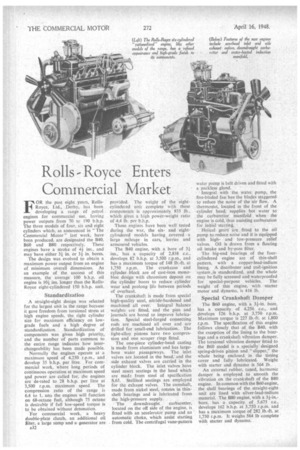Rolls Royce Enters Commercial Market
Page 34

If you've noticed an error in this article please click here to report it so we can fix it.
FOR the past eight years, RollsRoyce, Ltd., Derby, has been developing a range of petrol engines for commercial use, having power outputs from 70 to 190 b.h.p. The three models of four, six and eight cylinders which, as announced in "The Commercial Motor" last week, have been produced, are designated the B40, B60 and B80 respectively. These engines have a stroke of 41 ins., and may have either 31 in. or 31 in. bores.
The design was evolved to obtain a maximum power output from an engine of minimum overall dimensions. As an example of the success of this measure, the average 100 b.h.p. oil engine is 101 ins:longer than the RollsRoyce eight-cylindered 150 b.h.p. unit.
. Standardization
A straight-eight design was selected for the largest unit in the range because it gave freedom from torsional stress at high engine speeds, the right cylinder size for maximum efficiency on lowgrade fuels and a high degree of standardiAation. Standardization of components was given high priority, and the number of parts common to the entire range indicates how interchangeability has been made possible.
Normally the engines operate at a maximum speed of 4,250 r.p.m., and develop 35 b.h.p. per litre. For commercial work, where long periods of continuous operation at maximum speed arld power are called for, the engines are de-rated to 28 b.h.p. per litre at 3,500 r.p.m. maximum speed The compression ratio of the range is 6.4 to 1, atm the engines will function on 68-octane fuel, although 75 octane is desirable if full low-speed torque is to be obtained without detonation.
'For commercial work, a heavy double-plate clutch, an additional oil alter, a large sump and a generator are A32 provided. The weight of the eightcylindered unit complete with these components is approximately 835 lb., which gives a high power-weight ratio of 4.4 lb. per b.h.p.
These engines have been well tested during the war, the sixand eightcylindered models having covered • a large mileage in cars, lorries and armoured vehicles.
The B40 engine, with a bore of 31 ins., has a capacity of 2,838 c.c., develops 82 b.h.p. at 3,500 r.p.m., and has a maximum torque of 148 lb.-ft. at 1,750 r.p.m. The crankcase and cylinder block are of cast-iron monobloc design with chromium deposit on the cylinder bores to reduce cylinder wear and prolong life between periods of overhaul.
The crankshaft is made from special high-quality steel, nitride-hardened and machined all over. Integral balance weights are fitted, and the pins and journals are bored to improve lubrication. Special steel-forged connecting rods are machined all over and are drilled for small-end lubrication. The light-alloy pistons have two compression and one scraper rings fitted.
The one-piece cylinder-head casting is made from aluminium and has largebore water passageways. The inlet valves are located in the head; and the side exhaust valves are carried in the cylinder block. The inlet valves have steel insert seatings in the head which are made from steel of specification S.65. Stellited seatings are employed for the exhaust valves. 1 he camshaft, made from nickel steel, rotates in thinshell bearings and is lubricated from the high-pressure supply.
The downdraught carburetter, located on the off side of the engine, is fitted with an accelerator pump and an automatic choke, which assist starting from cold. The centrifugal vane-pattern water pump is belt driven and fitted with a packless gland.
Integral with the water pump, the five-bladed fan has the blades staggered• to reduce the noise of the air flow. A thermostat, located in the front of the cylinder head, supplies hot water to the carburetter. manifold when the engine is cold, thus assisting carburation for initial starting.
Helical gears are fitted to the oil pump to reduce noise and it is equipped with highand low-pressure relief valves. Oil is drawn from a floating oil intake and by-pass filter.
The big-end bearings of the fourcylindered engine are of thin-shell pattern, with a copper-lead-indium lining. A distributor and coil-ignition system ,is standardized, and the whole may be fully screened and waterproofed for special-purpose vehicles. The weight of this engine, with starter motor and dynamo, is 416 lb.
Special Crankshaft Damper
• The B60 engine, with a 31-in, bore. has a capacity of 4,256 c.c., and develops 126 b.h.p. at 3,750 r.p.m. Maximum torque is 227 lb.-ft. at 1,800 r.p.m. The specification of this engine follows closely that of the B40, with the exception of the lining to the bearings and a crankshaft vibration damper. The torsional vibration damper fitted to the B60 model is a specially designed spring-driven pinion and "slipper," the whole being enclosed in the timing cover and fully lubricated. Weight with starter and dynamo is 564 lb.
An external rubber, tuned, harmonic damper is employed to smooth the vibration on the crankshaft of the B80 engine. In common with the B60 engine, the shell bearings of the straight-eight unit are lined with silver-lead-indium material. The B80 engine, with a bore, has a capacity of 5,675 c.c., develops 162 b.h.p. at 3,750 r.p.m. and has a maximum torque of 282 lb.-ft. at 1,750 r.p.m. It weighs 564 lb complete • with starter and dynamo.












































































